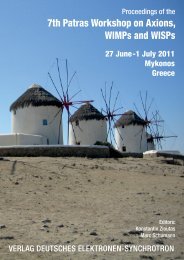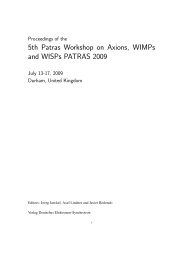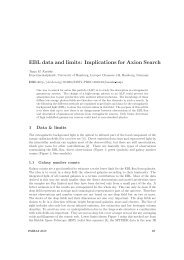Hamburg Neutrinos from Supernova Explosions ... - DESY Library
Hamburg Neutrinos from Supernova Explosions ... - DESY Library
Hamburg Neutrinos from Supernova Explosions ... - DESY Library
Create successful ePaper yourself
Turn your PDF publications into a flip-book with our unique Google optimized e-Paper software.
STEPHEN W. BRUENN, ERIC J. LENTZ, ERIC J. LINGERFELT, ANTHONY . . .<br />
gas <strong>from</strong> the neutrino-heating region will be transported directly to the shock, while downflows<br />
simultaneously will carry cold, accreted matter to the layer of strongest neutrino heating where<br />
a part of this gas, being cold, readily absorbs more energy <strong>from</strong> the neutrinos. The loss of<br />
energy accompanying the advection of matter through the gain radius is thereby reduced and<br />
more energy stays in the heating layer. A useful criterion for shock revival and successful<br />
neutrino driven explosions is the residency time of fluid elements in the heating layer [32].<br />
Longer residency times, by allowing fluid elements to absorb more energy, are thus favorable for<br />
explosions. The lateral motions associated with convection lengthen the heating layer residency<br />
time of some fluid elements, thereby further enhancing the effects of convection.<br />
Another important phenomenon missing in spherical symmetry was pointed out by [33] who<br />
discovered that the stalled shock is subject to low-mode aspherical oscillations, which is now<br />
referred to as the standing accretion shock instability or ‘SASI.’ The cause of this instability<br />
is still being debated, but it leads to enlargements of the heating layer in certain regions and<br />
its diminution in others. Where the heating region is enlarged, the residency times of fluid<br />
elements is lengthened, and the magnitude of neutrino heating is enhanced. Where the heating<br />
region is constricted, conditions are favorable for the establishment of down-flows or returnflows<br />
for large-scale convection. The diversion of infalling material by the distorted shock to<br />
the constricted regions adds to these effects. It has further been pointed out and supported by<br />
2D simulations with parameterized neutrino sources that the development of the SASI leads to<br />
the large asymmetries observed for SN 1987A and other supernovae, and might account for the<br />
large observed velocities of neutron stars [34, 35].<br />
A number of groups are actively engaged in modeling CCSNe with the aim of ascertaining<br />
the viability of the neutrino mechanism. These include the Princeton-CalTech-Israeli group<br />
using the Vulcan/2D code, the Swiss-Japanese group using the Zeus+IDSA code, the Garching<br />
group with using VERTEX code, and the FAU-NCSU-Oak Ridge group using the CHIMERA<br />
code, e.g., ([36, 37, 38, 39] and references therein to earlier work). Because modeling realistic<br />
neutrino transport in CCNSe is such a computational challenge, demanding exascale resources<br />
to fully implement, say, the solution for each neutrino specie of a multi-energy, multi-angle,<br />
GR Boltzmann transport in three spatial dimensions (i.e., the solution of the time evolution of<br />
neutrinos in a six-dimensional phase space), these groups have had to resort to various approximate<br />
approaches to reduce the dimensionality of the problem. Zeus+IDSA, VERTEX, and<br />
CHIMERA use a ray-by-ray approximation whereby the three spatial dimensions accessible to<br />
a neutrino are reduced to “one-and-one-half” dimensions—namely, a one-dimensional transport<br />
problem is solved along each of an ensemble of independent radial rays spanning the solid angle<br />
of the computational domain. Lateral neutrino pressure and advection, but not transport, are<br />
computed in neutrino optically thick regions. Vulcan/2D solves the transport equation along<br />
independent “energy rays,” thus ignoring non-isoenergetic scattering, specie coupling, and observer<br />
corrections, the latter omission being potentially serious as it leads, among other things,<br />
to a substantial non-conservation of energy and leptons [40].<br />
The codes also use different approximations in solving their respective transport equations.<br />
CHIMERA and Vulcan/2D use flux-limited diffusion (the latter also has an SN option),<br />
VERTEX uses a variable Eddington tensor closure with the latter calculated by the<br />
solution of a spherically averaged, model Boltzmann equation. Zeus+IDSA uses an Isotropic<br />
Diffusion Source Approximation (IDSA) [41], whereby the neutrino distribution is broken up<br />
into a trapped component and a streaming component. VERTEX and CHIMERA use approximate<br />
GR for both the gravity and transport, CHIMERA using a spherically symmetric<br />
post-Newtonian approximation gravitational potential supplemented by a Newtonian gravity<br />
86 HAνSE 2011








